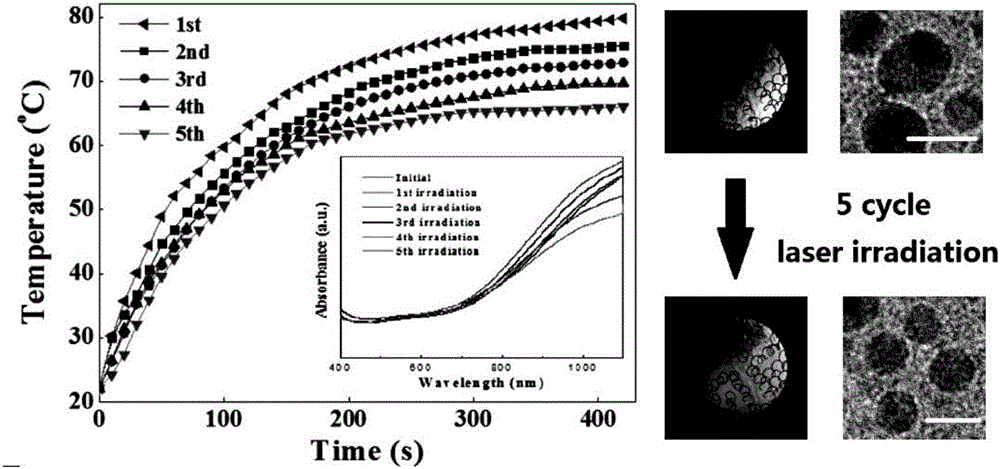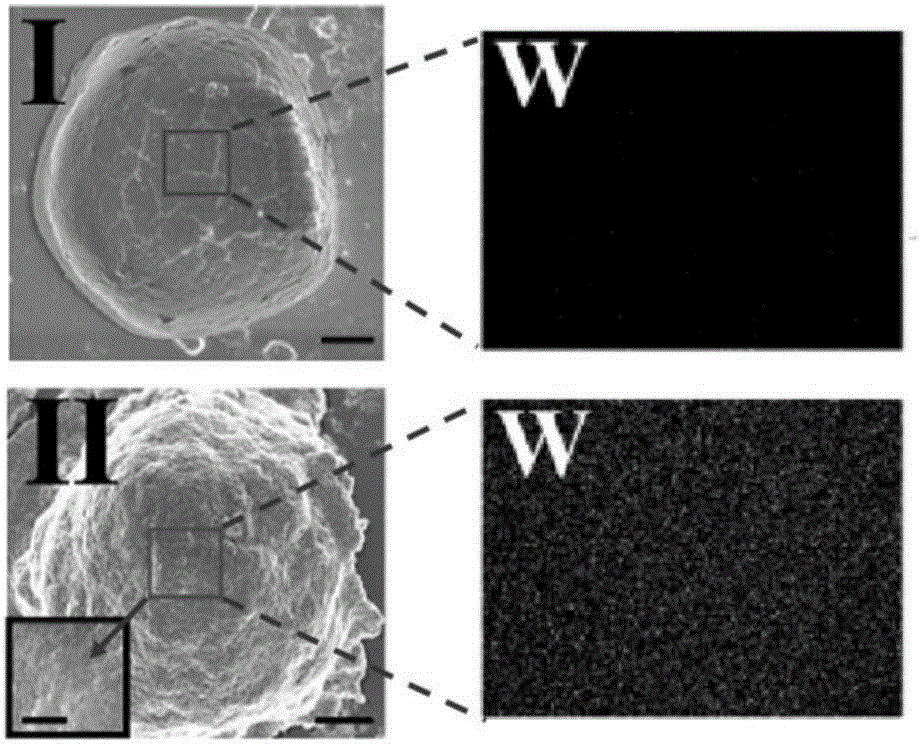Photothermal conversion nanoparticles for targeted thermal elimination of Tregs (regulatory T cells), preparation and application
A nanoparticle and light-to-heat conversion technology, applied in the field of materials for tumor immune intervention, can solve problems such as high treatment costs, weak autoimmunity, and inability to effectively kill cancer cells
- Summary
- Abstract
- Description
- Claims
- Application Information
AI Technical Summary
Problems solved by technology
Method used
Image
Examples
Embodiment 1
[0029] (1), weigh WCl 6 200 mg, dissolved in 50 mL of ethylene glycol under nitrogen protection, stirred and dissolved at room temperature to obtain a golden yellow solution, then added 300 mg of polyacrylic acid polymer with a molecular weight of 5KDa, stirred until completely dissolved, and then under nitrogen protection at 140°C Stir the reaction. After the system is heated, it is dark brown at first, then turns blue-green after 30 minutes, and finally turns dark blue after 1 hour, and remains unchanged. Continue heating for 1.5 hours, then cool down to 80 ° C, add 50 mL of deionized water, Continue to stir and react for 1 h, stop heating, centrifuge and purify the reacted solution, discard the supernatant, wash and disperse the product with deionized water, repeat this washing process three times, and finally obtain the purified product, which is dark blue W 18 o 49 Particle powder, TEM shows that its average particle size is 4.9nm.
[0030] (2) The prepared tungsten ox...
Embodiment 2
[0033] 1), weigh WCl 6 200 mg, dissolved in 50 mL of ethylene glycol under nitrogen protection, stirred and dissolved at room temperature to obtain a golden yellow solution, then added 300 mg of polyacrylic acid polymer with a molecular weight of 5KDa, stirred until completely dissolved, and then under nitrogen protection at 140°C Stir the reaction. After the system is heated, it is dark brown at first, then turns blue-green after 30 minutes, and finally turns dark blue after 1 hour, and remains unchanged. Continue heating for 1.5 hours, then cool down to 80 ° C, add 50 mL of deionized water, Continue to stir and react for 1 h, stop heating, centrifuge and purify the reacted solution, discard the supernatant, wash and disperse the product with deionized water, repeat this washing process three times, and finally obtain the purified product, which is dark blue W 18 o 49 Particle powder, TEM shows that its average particle size is 4.9nm.
[0034] (2) The prepared tungsten oxi...
Embodiment 3
[0037] 1), weigh WCl 6 200 mg, dissolved in 50 mL of ethylene glycol under nitrogen protection, stirred and dissolved at room temperature to obtain a golden yellow solution, then added 300 mg of polyacrylic acid polymer with a molecular weight of 5KDa, stirred until completely dissolved, and then under nitrogen protection at 140°C Stir the reaction. After the system is heated, it is dark brown at first, then turns blue-green after 30 minutes, and finally turns dark blue after 1 hour, and remains unchanged. Continue heating for 1.5 hours, then cool down to 80 ° C, add 50 mL of deionized water, Continue to stir and react for 1 h, stop heating, centrifuge and purify the reacted solution, discard the supernatant, wash and disperse the product with deionized water, repeat this washing process three times, and finally obtain the purified product, which is dark blue W 18 o 49 Particle powder, TEM shows that its average particle size is 4.9nm.
[0038] (2) The prepared tungsten oxi...
PUM
| Property | Measurement | Unit |
|---|---|---|
| The average particle size | aaaaa | aaaaa |
Abstract
Description
Claims
Application Information
 Login to View More
Login to View More - R&D
- Intellectual Property
- Life Sciences
- Materials
- Tech Scout
- Unparalleled Data Quality
- Higher Quality Content
- 60% Fewer Hallucinations
Browse by: Latest US Patents, China's latest patents, Technical Efficacy Thesaurus, Application Domain, Technology Topic, Popular Technical Reports.
© 2025 PatSnap. All rights reserved.Legal|Privacy policy|Modern Slavery Act Transparency Statement|Sitemap|About US| Contact US: help@patsnap.com



